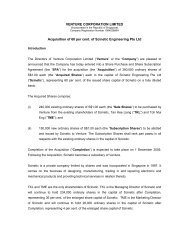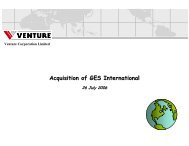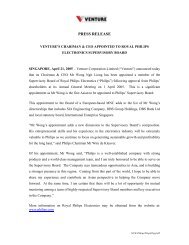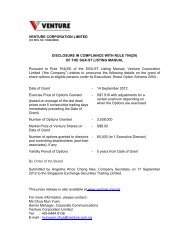Annual Report 2006 - Venture Corporation Limited
Annual Report 2006 - Venture Corporation Limited
Annual Report 2006 - Venture Corporation Limited
Create successful ePaper yourself
Turn your PDF publications into a flip-book with our unique Google optimized e-Paper software.
notes to financial statements<br />
December 31, <strong>2006</strong><br />
4 FINANCIAL RISKS AND MANAGEMENT<br />
i) Foreign currency risk<br />
The group operates internationally, giving rise to market risk from changes in foreign exchange rates. The group<br />
manages its foreign exchange exposure by matching revenue and costs in the relevant currencies to create a<br />
natural hedge and also through active currency management using derivatives such as forwards and currency<br />
options where necessary.<br />
The company has a number of investments in foreign subsidiaries, whose net assets are exposed to currency<br />
translation risk. No hedge has been taken up to mitigate this exposure as it does not impact cashflows.<br />
ii)<br />
Interest rate risk<br />
Interest rate risk refers to the risk experienced by the company and the group as a result of the fluctuation in<br />
interest rates. The group has cash balances placed as various forms of deposits with reputable international<br />
financial institutions and investments in fixed rate instruments of strong financial ratings. These deposits and<br />
investments are generally with short term maturities to provide the group the flexibility to meet working capital<br />
and other investments needs. Although the group’s borrowings are short term in nature and bear interest at<br />
market rates, management has the intention of refinancing the short term loan of $600,000,000 as at December<br />
31, <strong>2006</strong> subsequent to year end.<br />
iii)<br />
Credit risk<br />
Credit risk arising from defaults by counterparties on their contractual obligations is managed through the<br />
application of credit approvals, credit limits and monitoring procedures. The group has adopted a policy of<br />
only dealing with creditworthy counterparties and will require collaterals from customers with no track record<br />
of credit history. The group performs ongoing credit evaluation of their counterparties’ financial condition and<br />
regular meetings are conducted to monitor debt collection and credit risk exposure.<br />
The group enters into treasury transactions only with creditworthy institutions. It seeks to invest in quality<br />
investee companies and a majority of its fixed income investments are above investment grade. The group’s<br />
investments in credit derivative products are exposed to default risks of a portfolio of underlying credits.<br />
iv)<br />
Liquidity risk<br />
Liquidity risk refers to the risk in which the group has difficulties in meeting its short term obligations. Liquidity<br />
risk is managed by matching the payment and receipt cycle. The group has sufficient cash from operations and<br />
credit lines from financial institutions (Note 1) to fund its capital investments and working capital requirements.<br />
v) Investment risk<br />
Investment risk refers to the risk experienced by the group in its management of the return of funds invested in<br />
financial instruments. This risk includes market price risk due to fluctuations in interest rates, foreign currency<br />
exchange rates, prices of equities, debt securities and other financial contracts. Investment risk is managed<br />
through established investment policies and guidelines. These policies and guidelines are reviewed regularly<br />
taking into consideration changes in the overall market environment.<br />
vi)<br />
Fair value of financial assets and financial liabilities<br />
Other than the fair values of non-current available-for-sale assets and derivative financial instruments which are<br />
disclosed in Notes 7 and 20, the carrying amounts of the financial assets and financial liabilities reported in the<br />
balance sheet approximate the fair values of those assets and liabilities, due to the relatively short term maturity<br />
of these financial instruments.<br />
annual report <strong>2006</strong><br />
53















